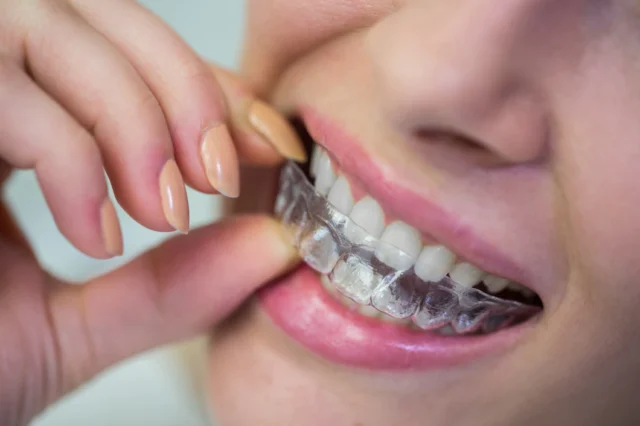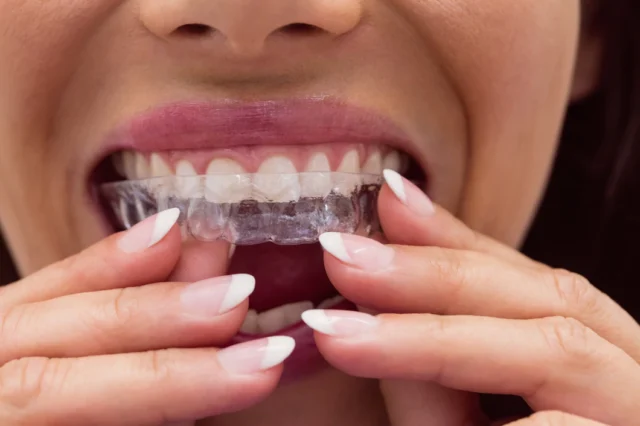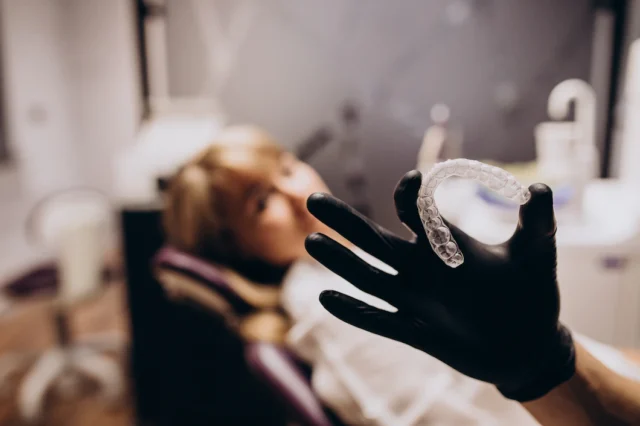
Invisalign is an alternative dental treatment for patients with malocclusion (misaligned teeth) who want straighter teeth without the uncomfortable wires and brackets of traditional braces. It involves a patented aligner technology that employs a series of clear plastic trays or aligners, custom-made to fit the shape of your teeth. Each aligner moves the teeth gradually until they are in their desired position.
This treatment is typically recommended in cases where the malocclusion is not too severe and should require little to no tooth extraction. The number of treatments one needs with Invisalign will depend on several factors including the severity of misalignment, patient age, and compliance with instructions.
What are the Benefits of Invisalign?

One benefit is greater convenience: the removable aligners can be taken out for eating and cleaning your teeth. In addition to avoiding certain sticky or chewy foods like taffy or caramels which can break metal brackets off, taking out your aligner also allows you to brush and floss as usual – something that can be difficult with fixed metal braces.
You’ll also benefit from fewer visits to the dentist’s office since there are no bands or wires to adjust. With every set of clear aligners switched out as directed by your orthodontist, you’ll see steady progress toward achieving the perfect smile!
These are just some of the benefits associated with Invisalign; however, it’s important to note that everyone’s orthodontic needs vary significantly. To find out how many sets of aligners you’d need, please consult a qualified orthodontist for Invisalign treatments in Belfast who will review your dental records and create a plan tailored to your individual circumstances.
How Does Invisalign Work?

The treatment typically follows the same steps as other orthodontic treatments: a patient’s dentist or orthodontist evaluates the person’s smile, takes impressions and X-rays, and then creates a customized plan with the help of 3-D imaging technology. This plan includes how many aligners are needed for the duration of treatment.
Aligners are changed out every two weeks in order for progress to happen steadily.
Throughout the entire process, periodic visits to a dentist or orthodontist’s office will be required so providers can check on tooth movement and patient comfort level.
How Many Treatments Does Invisalign Require?

Your dental professional can provide more information about how many treatments you need based on an evaluation of your dental health and alignment needs. During this assessment, they will decide if you need only 18 months or require 24-36 months of treatment with multiple sets of aligners over time.
Additional visits may also be required throughout treatment so that progress can be monitored and adjusted if necessary; these are known as checkups.
What Factors Impact the Number of Treatments Needed?

The number of treatments needed to achieve an ideal smile with Invisalign depends on the severity of your alignment issues. The time frame can be anywhere from six months to two years and beyond.
Many factors will influence how long it will take to effectively realign your teeth, including the types of misalignment issues present, the movement selected by your orthodontist, and the consistency with which you wear and care for your aligners.
Mild misalignment can generally be treated in a shorter amount of time than more serious issues. Orthodontic movement options such as agile models involve short-term changes that can reduce treatment length significantly when compared with traditional brackets-and-wires braces methods.
Additionally, wearing your aligners as prescribed and following recommended cleaning routines will ensure that each new tray is effective at continuing the realignment process.
Your orthodontist will be able to assess which type of orthodontic treatment is best for you after evaluating the severity of your alignment challenges and lifestyle preferences.
With dedicated care from you and supervision from a qualified professional, Invisalign treatments can help you attain the beautiful smile you’ve always wanted in a surprisingly short amount of time!
How Long Does Each Treatment Last?

Once you have received your initial set of aligners, you will need to wear each aligner for one to two weeks before moving on to the next. At regular intervals during treatment (which is typically every 4-6 weeks), you will need to have follow-up appointments with your orthodontist so progress can be monitored and adjustments made accordingly.
On average, patients will receive between 10 and 30 sets of aligners throughout their plan, so it is important to be mindful that everyone’s experience with Invisalign varies slightly depending on the complexity of their case and the severity of their misalignment.
It is essential that you follow instructions provided by your orthodontist if you want the best results possible in a timely manner.
Cost Overview

The average cost consists of several components: the fees for the doctor’s office visit, any dental work that needs to be done in advance (such as fillings or crowns), the cost for X-rays needed for imaging, and then finally, the cost for each set of aligners that you will need during your treatment. Additionally, there are other add-ons such as retainers or whitening options that you can choose.
It’s important to do research ahead of time when looking into costs so you know exactly what’s included in each estimate. The price range may vary widely (from $3000-$5000) depending on where you go and if any additional procedures are needed to prepare your teeth for treatment. For example, if you need extensive dental work like fillings or crowns before your treatment begins then this will likely increase the overall cost significantly.
In some cases, your insurance plan may help cover some expenses associated with Invisalign; however, it’s best to speak with both your doctor and provider ahead of time to confirm what coverage is available under your plan. Additionally, many orthodontic offices offer payment plans with low down payments and monthly payment amounts – this can make treatment more affordable for those without insurance coverage.
Conclusion
Determining the number of Invisalign treatments you need depends on your individual oral health situation, the severity of your misalignment, and the results you desire. It’s important to remember that we all have different needs and what works for one person could involve more or fewer treatments.
Invisalign is a good alternative to conventional braces and it also offers numerous benefits such as being practically invisible and easy to use. If you are considering Invisalign, be sure to consult with your dentist so they can evaluate your mouth and discuss with you what the best approach would be for achieving a straighter smile.









